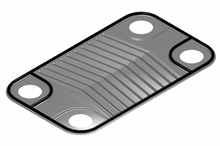Plate heat exchanger
A plate heat exchanger is a type of heat exchanger that uses metal plates to transfer heat between two fluids. This has a major advantage over a conventional heat exchanger in that the fluids are exposed to a much larger surface area because the fluids spread out over the plates. This facilitates the transfer of heat, and greatly increases the speed of the temperature change. It is not as common to see plate heat exchangers because they need well-sealed gaskets to prevent the fluids from escaping, although modern manufacturing processes have made them feasible.
The concept behind a heat exchanger is the use of pipes or other containment vessels to heat or cool one fluid by transferring heat between it and another fluid. In most cases, the exchanger consists of a coiled pipe containing one fluid that passes through a chamber containing another fluid. The walls of the pipe are usually made of metal, or another substance with a high thermal conductivity, to facilitate the interchange, whereas the outer casing of the larger chamber is made of a plastic or coated with thermal insulation, to discourage heat from escaping from the exchanger.
The plate heat exchanger (PHE) was invented by Dr Richard Seligman in 1923 and revolutionised methods of indirect heating and cooling of fluids.
Design of plate and frame heat exchangers


The plate heat exchanger is a specialized design well suited to transferring heat between medium- and low-pressure liquids. Welded, semi-welded and brazed heat exchangers are used for heat exchange between high-pressure fluids or where a more compact product is required. In place of a pipe passing through a chamber, there are instead two alternating chambers, usually thin in depth, separated at their largest surface by a corrugated metal plate.
The plates used in a plate and frame heat exchanger are obtained by one piece pressing of metal plates. Stainless steel is commonly used metal for the plates because it is able to withstand high temperatures, resistance to rusting while also being a strong material. The plates are often spaced by rubber sealing gaskets which are cemented into a section around the edge of the plates. The plates are pressed to form troughs at right angles to the direction of flow of the liquid which runs through the channels in the heat exchanger. These troughs are arranged so that they interlink with the other plates which forms the channel with gaps of 1.3-1.5 mm between the plates.
The plates produce an extremely large surface area, which allows for the fastest possible transfer. Making each chamber thin ensures that the majority of the volume of the liquid contacts the plate, again aiding exchange. The troughs also create and maintain a turbulent flow in the liquid to maximize heat transfer in the exchanger. A high degree of turbulence can be obtained at low flow rates and high heat transfer coefficient can then be achieved.
A plate heat exchanger consists of a series of thin, corrugated plates which are mentioned above. These plates are gasketed, welded or brazed together depending on the application of the heat exchanger. The plates are compressed together in a rigid frame to form an arrangement of parallel flow channels with alternating hot and cold fluids.
As compared to shell and tube heat exchangers, the temperature approach in a plate heat exchangers may be as low as 1 °C whereas shell and tube heat exchangers require an approach of gives 5°C or more. For the same amount of heat exchanged, the size of the plate heat exchanger is smaller, because of the large heat transfer area afforded by the plates (the large area through which heat can travel). Expansion and reduction of the heat transfer area is possible in a plate heat exchanger.
Another advantage of the heat exchanger is that it is easily dismantled for inspection and cleaning. The plates are also easily replaceable due the fact that plates can be removed and replaced individually. The main weakness of the plate and frame heat exchanger is the necessity for the long gaskets which holds the plates together. Although these gaskets are seen as a weakness towards this type of heat exchanger, it has been successfully run at high temperatures and pressures.
Evaluating plate heat exchangers
All plate heat exchangers look similar on the outside. The difference lies on the inside, in the details of the plate design and the sealing technologies used. Hence, when evaluating a plate heat exchanger, it is very important not only to explore the details of the product being supplied, but also to analyse the level of research and development carried out by the manufacturer and the post-commissioning service and spare parts availability.
For the above reasons, plate heat exchangers are used for better and more controlled heat transfer.
See also
Bibliography
- Sadik Kakac and Hongtan Liu (March 2002). Heat Exchangers: Selection, Rating and Thermal Design (2nd Edition ed.). CRC Press. ISBN 0-8493-0902-6.
{{cite book}}:|edition=has extra text (help)CS1 maint: year (link) - T. Kuppan (February 2000). Heat Exchanger Design Handbook (1st Edition ed.). CRC Press. ISBN 0-8247-9787-6.
{{cite book}}:|edition=has extra text (help)CS1 maint: year (link) - J. M. Coulson and J. F. Richardson (1999). Coulson & Richarson's Chemical Engineering Volume 1 (6th Edition ed.). Butterworth Heinemann. ISBN 0-7506-4444-3.
{{cite book}}:|edition=has extra text (help)
External links
- Designing Plate Heat Exchangers
- A list of published articles pertaining to plate heat exchangers
- Update on compact composite plate heat exchangers by Per F. Peterson and Haihua Zhao, University of California, Berkeley.
- A screening method for the optimal selection of plate heat exchanger configurations by J.M.Pinto and J.A.W.Gut, University of São Paulo, Brazil.
- Designing novel compact heat exchangers for improved efficiency using a CFD code by Athanasios G. Kanaris, Katerina A. Mouza and Spiros V. Paras, Aristotle University of Thessaloniki.
